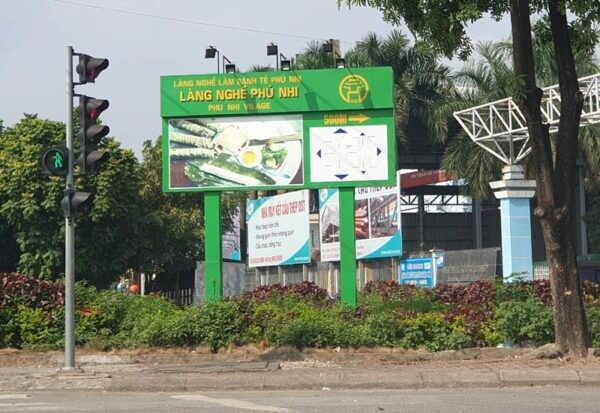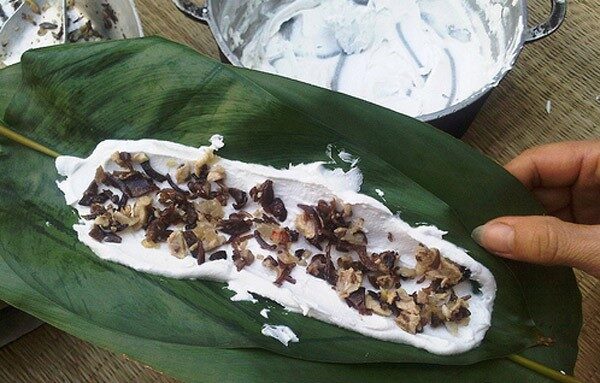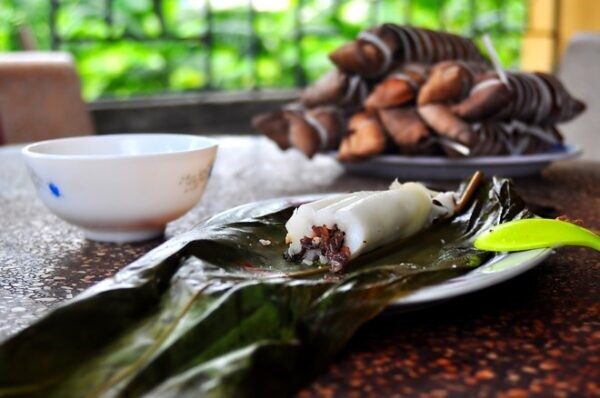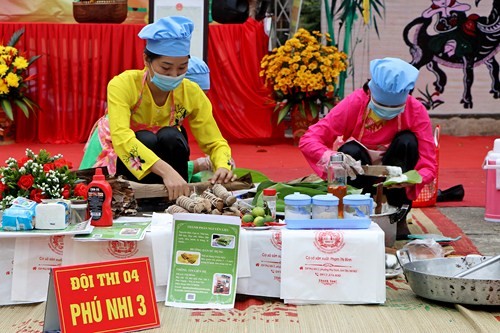Banh te is a traditional cake in various parts of Vietnam. The cake is created with plain rice flour and is a rustic, delicious, healthful, and inexpensive rural gift. The cake is covered in flour, wrapped in Phrynium leaves, then boiled until done. Phu Nhi village, located in Son Tay town, specializes in the production of banh te.

Banh Te Craft village at Phu Nhi Village – Son Tay Town

Ingredients for making banh tet include plain rice, pork, wood ear, onions… and Phrynium leaves, banana leaves to wrap the cake.
Phu Nhi is an ancient village that dates back to the late 1800s in Quang Oai district, Son Tay town, and is now located in Phu Thinh ward, Son Tay town. This location is well-known for the art of creating banh te. Son Tay town has organized various research and information gathering activities on Banh te creating craft in order to respect the profession and retain the traditional profession related with tourism development.
Son Tay town, directly near to Phuc Tho district, has a street that specializes in selling hot cakes as well as Ba Vi dairy goods. Not only that, even tourist destinations in Son Tay sell banh te in traditional marketplaces and restaurants.
Banh te at Phu Nhi village are folk associated with an anecdote about the touching love story of a couple named Phu and Nhi that has been handed down to this day. The profession of making Banh te is found in many places in the country and in Hanoi. However, the difference of Banh te at Phu Nhi village with other types of cakes is in the taste, spices and processing skills of the workers to make the deliciousness and difference of the cake. That’s also the difference in the wrapping material: The cake is made of wild phrynium leaves, and the outermost is wrapped in dried banana leaves.
The filling of banh te at Phu Nhi village is very sophisticated and thorough: The glutinous rice is selected with delicious, naturally fragrant rice. The filling is made from popular agricultural products, including: Pork, wood ear, dried onion, a little pepper, and spices. Meat plays an important role because it determines most of the quality and value of banh te at Phu Nhi village. It must be fresh, delicious, clean, ensure food safety and be shoulder meat.
Phrynium leaves have a bright green color, after washing the leaves will be drained. Rice: Wash, soak in water and then drain, then wet grind with a stone mortar into a thin water powder, stir well, then soak and soak the flour. The water powder is then simmered, people just boil and stir continuously until the dough is soft and smooth, avoiding lumps and especially the dough is not cooked or sizzling, this stage is called “powder”. The stitching of the dough is extremely important in the baking process, whether the cake is delicious or not is thanks to the quality of the flour being speared. Pork, wood ear: wash with water, cut into small pieces, mix well. Prepare the ingredients, drain the dough and fill the cake, then pack the cake/
Banh te wrapped with phrynium leaves is popular in many places. In Son Tay, banh te is wrapped with dried banana leaves, so the cake has a brown outer shell. After wrapping, the cake is tied with white flour, so the cake is brown, with white stripes, quite eye-catching. Banh te in tourist areas is usually only 15-20cm long, Banh te of Phu Nhi Son Tay is about 5cm longer. After wrapping, the cake is placed in a pot and steamed in boiling water for about 30 minutes.
Banh te dipped with fish sauce sprinkled with ground pepper with lemon, garlic, chili or dipped with chili sauce. The cake is best eaten when freshly picked out. Peeling the green leaves, the white cake appears, the aroma of the meat is very attractive. When eating, people use a small knife to cut the cake into pieces, arrange it on a plate, then sip to enjoy and feel the bold, fatty, aromatic flavor of the filling, the fleshy and greasy taste of rice flour. On the full moon day, anniversaries and the Lunar New Year, the Son Tay people often make Banh te to worship. Nowadays, Banh te of Son Tay are made all year round and are easy to buy.

The cake is best eaten when freshly picked out. The cake is served hot with delicious fish sauce, adding a little pepper makes it even more delicious. Photo: internet
In 2007, Phu Nhi was recognized as a traditional village of banh tet. In 2010, Banh tet of Phu Nhi was granted a Certificate by the National Office of Intellectual Property, Ministry of Science and Technology to recognize the Phu Nhi brand name for the craft village. Currently in the village there are up to 100 households specializing in the production of banh te for business purposes. There are families that produce an average of 1,000 – 2,000 units per day.

“Traditional Banh te in Phu Nhi Craft Village” Contest”
Every year in Phu Nhi, a contest called “Traditional Banh te in Phu Nhi Craft Village” is held to preserve and promote the value of traditional craft villages; capacity building for banh tet production facilities in the village; and an opportunity to promote traditional banh te products, step by step, to make Phu Nhi’s banh te products a highly competitive commodity brand in the market…
Quynh Quy
